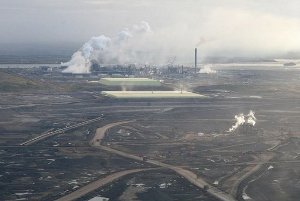
Canada's oil sands project has created an "urban heat island" effect, drying out a city-sized area and raising the local temperature by more than a degree.
In a study released last month, University of Alberta researchers found that existing mining activities (which occupy more than 600 sq. km or an area slightly smaller than Edmonton) have dramatically raised temperatures but have not yet changed rain patterns or thunderstorms.
The study, published in the journal Earth Interactions, found that summer overnight minimum temperatures near the oil sands have increased by about 1.2 C compared to the regional average due to waste heat released by the world's largest energy project.
"It's a big disturbed area. There is a definite heat island effect as there would be in any city of that size," notes Daniel Brown, the study's lead author and a University of Alberta PhD student studying thunderstorms.
The area has also become drier than the surrounding region probably due to the removal of millions of spruce and aspen trees.
Massive open pit mines coming
The project's active mining footprint now disturbs 715 sq. km. More than 1,300 sq. km have been approved for open pit mines but that could grow to 4,800 km, an area nearly half the size of Toronto GTA (7,000 km) or equal in size to the state of Rhode Island.
The project's massive lakes of toxic mining waste, which occupy a 170 sq. km area, may also moderate surface energy temperatures by trapping heat at night and cooling things during the day.
In addition, steam plants or in situ projects, which use more energy than the mines by steaming deep bitumen deposits, are expected to directly disturb another 6,800 sq. km of forest or an area larger than open pit mines.
Computer model in the works
To date the oil sands has not impacted the volume or direction of lightning strikes like in many high energy U.S. cities.
Due to its tall buildings, air pollution and asphalt heat sinks, the city of Houston, Texas now attracts nearly twice the number of lightning strikes as the local region. High energy industrial activity in Louisiana may be responsible for additional lightening strikes as well.
"Lightning is erratic and it takes years to find an effect," notes Brown. His study didn't find an effect yet in the oil sands.
But he noted that complex local topography and limited weather data over the last 17 years may make it difficult to yet detect one.
"We are going to do more research and hope to have a computer model" that can make weather predictions based on the projects heat island effect within a year.
A 2009 study conservatively estimated that the oil sands will eventually disturb 1,613,887 hectares or an area 20 times the size of the City of Calgary, 40 times the size of the City of Denver and 17 times the size of East/West Berlin.
[Tags: Energy, Envrionment.] ![]()
Read more: Energy, Science + Tech, Environment















Tyee Commenting Guidelines
Comments that violate guidelines risk being deleted, and violations may result in a temporary or permanent user ban. Maintain the spirit of good conversation to stay in the discussion.
*Please note The Tyee is not a forum for spreading misinformation about COVID-19, denying its existence or minimizing its risk to public health.
Do:
Do not: